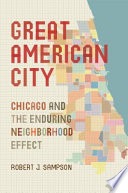
Main content start
Robert J. Sampson
Sociology
Harvard University
Fellowship year
2002-03 - University of Chicago - Study 51
1997-98 - University of Chicago - Study 51
1997-98 - University of Chicago - Study 51
Tyler Books
| Book Cover | Book Title and link |
|---|---|
 | Laub, John H. Samson, Robert J. . 2003. Shared beginnings, divergent lives: delinquent boys to age 70. Cambridge MA: Harvard University Press |
 | Sampson, Robert J.. 2011. Great American city: Chicago and the enduring neighborhood effect. Chicago; London: University of Chicago Press |
Tyler Journal Articles
Sampson, Ralph J; Raudenbush, Stephen W; . 2004. The social structure of seeing disorder. 67(4): 319-342.
Sampson, Robert J.; . 2003. The neighborhood context of well-being. 46(3 SUPPL.): S53-64.
McAdam, Doug; Sampson, Robert J.; Weffer, Simon; MacIndoe, Heather; . 2005. "There will be fighting in the streets": The distorting lens of social movement theory. 10(1): 1-18. https://mobilizationjournal.org/doi/abs/10.17813/maiq.10.1.a62814651h028540
Eggleston, Elaine P.; Laub, John H.; Sampson, Robert J.; . 2004. Methodological sensitivities to latent class analysis of long-term criminal trajectories. 20(1): 1-26. https://doi.org/10.1023/B:JOQC.0000016696.02763.ce
Sampson, Robert J.; Laub, John H.; . 2003. Life-course desisters? Trajectories of crime among delinquent boys followed to age 70. 41(3): 555-592. https://doi.org/10.1111/j.1745-9125.2003.tb00997.x
Sampson, Robert J.; Bartusch, Dawn Jeglum; . 1998. Legal Cynicism and (Subcultural?) Tolerance of Deviance: The Neighborhood Context of Racial Differences. 32(4): 777.
Sampson, Robert J.; Raudenbush, Stephen W.; . 1999. Systematic social observation of public spaces: A new look at disorder in urban neighborhoods. 105(3): 603-651. https://doi.org/10.1086/210356
Raudenbush, Stephen W.; Sampson, Robert; . 1999. Assessing direct and indirect effects in multilevel designs with latent variables. 28(2): 123-153. https://doi.org/10.1177/0049124199028002001
Sampson, Robert J.; . 2003. The neighborhood context of well-being. 46(3 SUPPL.): S53-64.
McAdam, Doug; Sampson, Robert J.; Weffer, Simon; MacIndoe, Heather; . 2005. "There will be fighting in the streets": The distorting lens of social movement theory. 10(1): 1-18. https://mobilizationjournal.org/doi/abs/10.17813/maiq.10.1.a62814651h028540
Eggleston, Elaine P.; Laub, John H.; Sampson, Robert J.; . 2004. Methodological sensitivities to latent class analysis of long-term criminal trajectories. 20(1): 1-26. https://doi.org/10.1023/B:JOQC.0000016696.02763.ce
Sampson, Robert J.; Laub, John H.; . 2003. Life-course desisters? Trajectories of crime among delinquent boys followed to age 70. 41(3): 555-592. https://doi.org/10.1111/j.1745-9125.2003.tb00997.x
Sampson, Robert J.; Bartusch, Dawn Jeglum; . 1998. Legal Cynicism and (Subcultural?) Tolerance of Deviance: The Neighborhood Context of Racial Differences. 32(4): 777.
Sampson, Robert J.; Raudenbush, Stephen W.; . 1999. Systematic social observation of public spaces: A new look at disorder in urban neighborhoods. 105(3): 603-651. https://doi.org/10.1086/210356
Raudenbush, Stephen W.; Sampson, Robert; . 1999. Assessing direct and indirect effects in multilevel designs with latent variables. 28(2): 123-153. https://doi.org/10.1177/0049124199028002001
